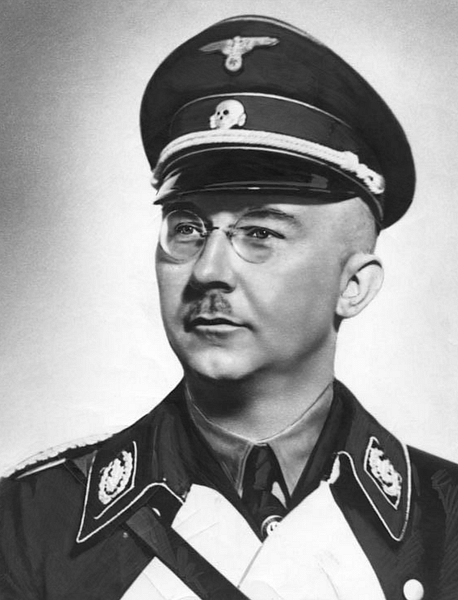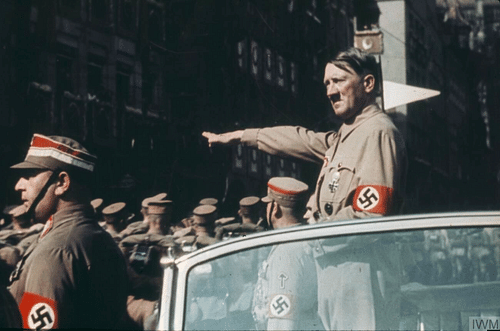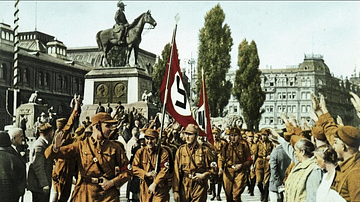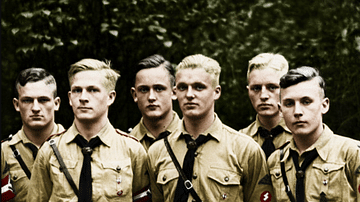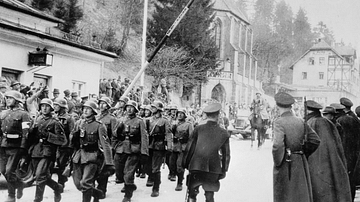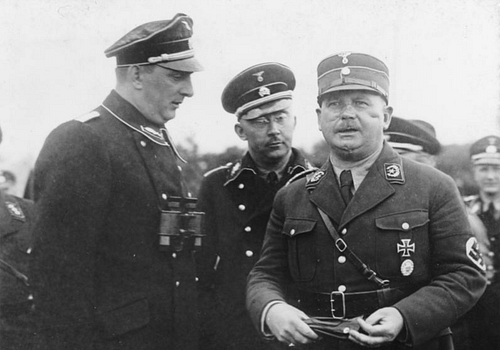
The Night of the Long Knives (aka Blood Purge or Röhm-Putsch) of 30 June 1934 was a purge of the Nazi Sturmabteilung (SA) paramilitary group which continued through 1 and 2 July. Adolf Hitler (1889-1945), wary of the growing power of the SA, embarrassed by its thuggish behaviour now that he was the chancellor of Germany, and in need of the support of the German Army, which saw the SA as a rival, ordered the assassination of the SA leader Ernst Röhm (1887-1934) along with many other key SA commanders and political enemies of the new Nazi regime. Justified as a purge of dangerous plotters against the state, the Night of the Long Knives revealed that the Nazi leadership regarded themselves as above the law.
The SA
Adolf Hitler became the leader of the Munich-based NSDAP (National Socialist German Workers' Party) in 1921. The party was neither socialist nor at all interested in workers, but Hitler had chosen the name to give his ultra-nationalist party as wide an appeal as possible. Known as the Nazi party, it was also vehemently anti-Semitic and against the German establishment. The SA or Sturmabteilung paramilitary group had been formed in 1921 and was given various functions, such as protecting Nazi party meetings, distributing propaganda, intimidating voters, and attacking party rivals or those identified as 'undesirables', like Jewish people. As Hitler had said, "We must struggle with ideas, but if necessary also with fists" (Hite, 116). From 1924, the SA began to wear brown army surplus uniforms, hence their nickname the Brownshirts.
The SA's growing membership in the early 1920s had already put Hitler on the alert. He decided to create his own personal bodyguard, a much smaller but more loyal group called the Stosstrupp-Hitler (Hitler Shock Troop). Nevertheless, the SA was involved in the infamous Beer Hall Putsch or Munich Putsch, the failed Nazi coup in November 1923. After the failure of the putsch, Hitler and his leading associates were found guilty of treason and imprisoned, albeit for what turned out to be short sentences. The immediate fallout of the putsch was a setback as the Nazi party and SA were banned (temporarily), and the Stosstrupp-Hitler was disbanded. However, the publicity of the court case against Hitler and his excellent oratory skills did actually increase interest in both the Nazi cause and the SA. Temporarily called the Frontbann, there was a huge rise in SA membership from 2,000 in 1923 to 30,000 stormtroopers in 1924.
The SA's growth was overseen by its leader Ernst Röhm. A short, stocky, ruthless man, who carried impressive facial scars from wounds sustained in WWI, Röhm had been instrumental in forming the "gymnastics and sports" branch of the Nazi party, which had then morphed into the SA. As one of Hitler's oldest allies, Röhm had also participated in the Beer Hall Putsch.
The SS
Hitler became wary again of the ever-growing SA. Consequently, in 1925, he had another go at creating a rival to the SA, and this time he was much more successful. The Schutzstaffel (SS) paramilitary group swore loyalty to Hitler personally. From 1929, the SS was led by Heinrich Himmler (1900-1945), another veteran of the Munich Putsch. The SS was employed as a 'protection squad', Hitler's personal bodyguard, as a sort of party police, and to generally demonstrate Nazi power in public. The SS was smaller and more elite than the SA, both in its recruitment and training methods. Röhm saw that the SS was a serious rival to his own position, and so he left the party in May 1925. Hitler would not agree to Röhm's idea that the SA play the role of a revolutionary military organisation that could rival the German Army (Reichswehr). Röhm spent the next five years in Bolivia. Meanwhile, the SA continued to grow under new leadership, reaching 100,000 members by 1929.
By the early 1930s, Hitler was still far from his goal of becoming leader of Germany, the (largely) peaceful route to political power he had chosen since the Beer Hall Putsch was not working as the Nazis simply could not win enough seats in general elections. Consequently, Hitler again turned to the SA, and Röhm was welcomed back as its leader in January 1931. Röhm was now permitted to reorganise the SA along more military lines. By 1933, the SA boasted 2.3 million members.
Hitler & the SA Threat
The SA was directly involved in the final Nazi push for power. The SA intimidated voters in the 1932 election which saw the Nazi Party gain sufficient votes for Hitler to be invited to become chancellor. The Reichstag Fire of 27 February 1933, when the German parliament was set ablaze, was supposedly caused by a Communist, Marinus van der Lubbe, although it may well have been a Sturmabteilung operation since Hitler wanted to demonstrate that the Left was a mortal danger to the good of the state. Then, in the election campaign of March 1933, the SA continued its usual activity of inhibiting the campaigns of rival parties and intimidating voters at the polling stations. The Nazis gained 44% of the votes in the election.
Hitler had to maintain the loyalty of the German Army or he could be ousted by force. The army saw the SA as a direct threat to its role in the state. In addition, the minister of defence, General Werner von Blomberg (1878-1946), criticised Hitler in private for not doing more to curb the excessive violence of the SA. Assured himself of the way the wind was blowing, Hitler made reassurances to the generals that he would decapitate the SA and ensure only the army had the right to bear arms. With the army and the SS, Hitler no longer needed the embarrassment of the thuggish SA. Perhaps most important of all in the longer term, Hitler needed the army if he was to pursue his ideas for an expanded Germany and eventual domination of Europe. He also needed the support of the president, Paul von Hindenburg (1847-1934), at least in public. Hindenburg informed Hitler that the current political instability must be sorted out or he would declare martial law and put the army in charge of the state. Hitler had to act and act quickly.
The Putsch That Never Was
Röhm and the SA were accused, without any evidence, of stockpiling arms and plotting a revolution against the fledgling Nazi regime. Rumours against Röhm were fed to Hitler by Röhm's greatest rivals, Hermann Göring (1893-1946) and Himmler. A story was cooked up that Röhm had received 12 million marks from France to launch a coup d'etat. Röhm had not helped himself either by publicly talking up the SA's power. The SA also had plausible and widely-known grievances that might motivate the organisation to commit rash actions. The SA police had been dissolved across Germany in 1933, the SA membership had a higher percentage of unemployed members than other Nazi bodies, and many in the SA felt that they had not really gained anything from the Nazi party winning power. Röhm had stated in a speech that the SA would "not permit the German revolution to lose its momentum or be betrayed by the non-fighters half-way to the goal" (Hite, 176). The final straw may have been a speech Röhm gave on 28 February 1934 when he confidently declared the SA was Nazi Germany's primary armed force and the Reichswehr in future would become a mere training corps for the Sturmabteilung. Röhm's homosexuality had never bothered Hitler before, but now it was used as another excuse to attack the SA leader. So a dramatic cull of the SA was planned, later known as the Blood Purge or Night of the Long Knives, but actually a period of violence spanning from 29 June to 1 July 1934. The Nazis called their purge Operation Hummingbird. It was carried out across Germany and Austria by the SS and Gestapo (the Nazi secret police), using weapons and transport supplied by the army.
Röhm's Execution
Hitler flew to Munich and, accompanied by an SS squad, stormed into the SA headquarters, the Brown House, ripping badges from the SA commanders there. Röhm and his entourage were arrested in the spa town of Bad Wiessee on 30 June. Röhm was roused from his bed in the Hotel Hanselbauer. Hitler was there, as he later recounted to Albert Speer (1905-1981), his chief architect: "We were unarmed, imagine, and didn't know whether or not those swine might have armed guards to use against us…In one room we found two naked boys" (Speer, 91). Other versions have Hitler armed with a gun as he entered the hotel while the building was safely surrounded by SS troops. With Röhm in custody, the word Kolibri ("hummingbird") was sent as a signal to Göring and Himmler to proceed in Berlin with more arrests of SA commanders and any other enemies of the Nazis. The SS and Gestapo worked their way through a prearranged list of 82 names.
Röhm was put in a cell in the Stadelheim Prison in Munich, the six SA men arrested with him were immediately lined up against a wall and shot. Hitler later stated that 77 conspirators had been shot immediately in the Night of the Long Knives. Another 110 SA leaders were also identified for execution, a process helped by an SA-insider called Viktor Lutze (1890-1943). To guard against any SA reprisals, Hitler had already mobilised the SS, the army, and the police. Speer recalls that in Berlin on 30 June, "Soldiers in battle array were encamped in the Tiergarten. Trucks full of police holding rifles cruised the streets" (90-1). Deprived of its leadership, the SA could do little to resist the purge.
On 1 July, Röhm was shown a newspaper with the story of the failed "Röhm Putsch" and then offered a pistol to shoot himself with, but he refused. According to some sources Röhm stated, "If I am to be killed, let Adolf do it himself" (Shirer, 221). Either the SS commander Theodor Eicke (1892-1943) or his adjutant Michael Lippert (or both) then shot Röhm, who had opened his shirt to receive the fatal blow. Significantly, perhaps, Eicke was promoted on 4 July to become the Nazi inspector of concentration camps. Röhm was erased from Nazi history. Official photographs were removed from sight. All copies of the propaganda film Victory of Faith, a film of the 1933 Nuremberg Rally, were destroyed on Hitler's orders since it had shown the Führer and Röhm on friendly terms (a single copy of the film was rediscovered in Britain in the late 20th century). Even books which had photographs of Hitler and Röhm together were destroyed.
Dr Hans Frank (1900-1946), the Nazi's leading expert in law, raised concerns over the legal implications of the planned executions. Another 20 executions of the original 110 SA leaders arrested were carried out despite these legal concerns. Those detainees who avoided execution were sent to concentration camps. The more secret killings went on. Hitler used the chaos of the purge to eliminate other rivals and threats to his power, people with no links at all to the Sturmabteilung. In all, 478 people were murdered in the purge, often shot in their homes or places of work without warning. The most prominent non-Nazi figures who were assassinated included the left-leaning Nazi politician Gregor Strasser (1892-1934), the pro-Catholic politician Erich Klausener (1885-1934), who had criticised the Nazis in a speech a few weeks earlier, and the former chancellor General Kurt von Schleicher (1882-1934) and his wife. The retired Bavarian politician Gustav Ritter von Kahr (1862-1934), who had worked against Hitler during the Beer Hall Putsch, was executed by the SS. Many of these deaths were reported as suicides. There were a few who had lucky escapes. SS troops came to the house of the Conservative politician Gottfried Treviranus (1891-1971), but he managed to flee through his back garden, eventually reaching the safety of Britain.
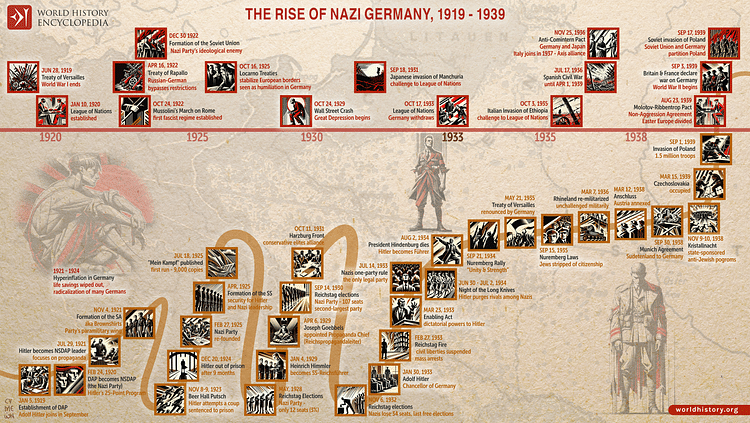
Aftermath
The attack on the SA was widely seen by the public as a necessary control on what was, after all, merely a gang of thugs. The Night of the Long Knives might have been a bloody affair, but it had, said Hitler, avoided a much bloodier civil war. The former president Hindenburg agreed with this assessment and publicly praised Hitler's actions against the SA: "You have saved the German nation from serious danger", he said (Hite, 178). Still, the Nazi party now looked more than ever capable of anything inside or outside the law, and Hitler felt it necessary to give a special speech to the Reichstag parliament justifying the purge. Hitler played on the fact that his enemies had been old friends, but his respect for law and order had, nevertheless, made the purge a necessity:
In that hour I was responsible for the fate of the German people, and thereby I became the supreme judge of the German people. I gave the order to shoot the ringleaders in this treason, and I further gave the order to cauterize down to the new flesh the ulcers of this poisoning of the wells in our domestic life. Let the nation know that its existence – which depends on its internal order and security – cannot be threatened with impunity by anyone. And let it be known for all time to come that if anyone raises his hand to strike the state, then certain death is his lot.
(Cimino, 89)
In private, Hitler confided that "It has been terribly hard for me to part with comrades who fought for years together with me" (Stone, 69). A final touch was made to legalize the purge on 3 July, with a statute signed by Hitler. The statute read: "The measures taken on 30 June and 1 and 2 July to crush treasonable attacks on our nation are a legal act of self-defence" (Cimino, 83).
The Nazi propaganda message, promoted via print and radio, was that the purge was merely a cleaning up of the party, a removal of immoral men who had practised homosexual acts amongst themselves and with young boys. Men who had then plotted to take power by force. The victims of the Night of the Long Knives were officially described by the party as "undisciplined and disobedient characters and anti-social or diseased elements" (Gellately, 207). The murder of those who had no SA connections was put down to unfortunate circumstances, the acts of overzealous operatives who had exceeded their orders. Many people were prepared to take Hitler at face value. As Victor Klemperer (1881-1960), the celebrated Jewish diarist, noted in one entry that July: "The confusion in the populace's ideas is shocking. A very calm and easygoing mailman…said to me … 'Well, he [Hitler] simply sentenced them [the SA leaders]'" (Klemperer, 74).
Many people did see through the smoke and mirrors and now realised for the first time that the Nazis were capable of anything, that if laws obstructed their wishes, then the laws would be changed or simply ignored. Adolf Hitler had become not only the guardian of the law, he was the law. When the German Army no longer swore loyalty to the constitution but to Hitler personally, the last piece of the power puzzle fell into place. The Führer was now untouchable.
Although the SA was never the same organisation again after the Night of the Long Knives, it was still used, under its new commander, the duplicitous Lutze, to attack anyone the Nazi regime deemed a threat. The headquarters of the SA was moved from Munich to Berlin so that Hitler could keep a better watch on the organisation. Some of the functions of the SA, such as running concentration camps, were taken over by the SS in 1934. The rising power of Himmler and the SS now made those still capable of independent thought realise that speaking out against the Nazi regime would almost certainly end in severe consequences. There was, too, the question of who would Hitler attack next. The most notorious episode of SA violence provided the answer. The Kristallnacht (Reichkristallnacht) or 'Night of Broken Glass' saw SA and SS stormtroopers attack Jewish people and property across Germany and Austria on 9-10 November 1938. The Nazis had turned from attacking themselves to systematically attacking anyone they considered their enemy. And so the nightmare of totalitarianism became a reality that would last until Germany's almost total destruction in 1945 at the end of the Second World War.

